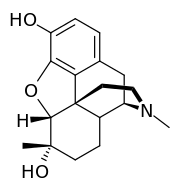Methyldihydromorphine
Methyldihydromorphine[1] is a semi-synthetic opioid originally developed in Germany in 1936, controlled under both domestic law and UN conventions because of its possible potential for abuse. Methyldihydromorphine is related to heterocodeine and is not a synonym for dihydrocodeine or dihydroheterocodeine (6-methoxydihydromorphine).
 | |
| Clinical data | |
|---|---|
| ATC code |
|
| Legal status | |
| Legal status |
|
| Identifiers | |
| |
| CAS Number | |
| PubChem CID | |
| ChemSpider | |
| UNII | |
| CompTox Dashboard (EPA) | |
| Chemical and physical data | |
| Formula | C18H23NO3 |
| Molar mass | 301.386 g·mol−1 |
| 3D model (JSmol) | |
| |
| |
| | |
This compound is a derivative of hydromorphone[2] It has been found to be 33 per cent the analgesic potency of morphine with a substantially longer duration of action.[2]
So far, little is currently known about this compound. It is a Schedule I controlled substance in the United States with an ACSCN of 9304 and a 2013 annual manufacturing quota of 2 grams.[3]
References
- U.S. Patent 2,104,058
- A. K. Reynolds and Lowell O. Randall (1957). Morphine & Allied Drugs. Toronto: University of Toronto Press. p. 194.
- Quotas - 2013, Drug Enforcement Administration
This article is issued from Wikipedia. The text is licensed under Creative Commons - Attribution - Sharealike. Additional terms may apply for the media files.